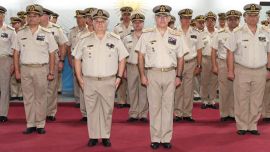Bringing to a close the United States’ largest-ever government-to-government transfer of official declassified documents, President Donald Trump’s administration handed over some 5,600 new files to the Argentine government yesterday, files that will shed new light on the 1976- 1983 military dictatorship.
US officials presented the final tranche of declassified records at an official handover ceremony at the National Archives Building in Washington DC. The documents are the last batch of a series of releases agreed when former US President Barack Obama had visited Buenos Aires on March 24, 2016 – the date that marks the anniversary of the military coup that brought the Junta to power.
Representing Argentina, Justice Minister German Garavano and Argentina’s Ambassador to the United States, Fernando Oris de Roa, received a symbolic box from US Archivist David Ferriero full of DVDs, containing more than 43,000 pages detailing events spanning 1975-1985.
In total, the United States has handed nearly 50,000 documents, officials said. According to John Powers, associate director of the information security oversight office at the National Archives, a total of 380 government staff from 16 agencies worked on the project.
Archivist Ferriero explained that US national archive staffs had logged 32,000 hours working on this project and that 97% of the documents would be released unredacted. The CIA, FBI, Defence, Justice and State departments provided the majority of the files.
‘HISTORIC EVENT’
“This is a historic event, one that will permit crimes against humanity judicial processes to continue, to know more about the dark period that existed in our country,” Garavano said.
The Justice minister highlighted in his comments the importance of advocacy work undertaken by Argentine human rights organisations such as CELS (Centre for Legal and Social Studies) and the Mothers and Grandmothers of the Plaza de Mayo, who have campaigned tirelessly for the declassification of the files.
He also stressed how the excellent relations President Mauricio Macri has with both Trump and Obama had been critical in allowing the project to be completed.
Amongst those in the audience at the event were former US diplomatic personnel, such as the former human rights officer of the US Embassy in Argentina, Allen “Tex” Harris, and former US ambassador Fernando Rondo, who had worked at the US State Department’s Argentine desk in Washington DC during the dictatorship era.
“These documents represent a new model of declassification diplomacy, as they are rich in detail, riveting in content and grim, as death is recorded in them,” explained National Security Archive director Carlos Osorio, who served as a special advisor on the declassification project.
“The files have the names of the perpetrators and the victims. They provide a level of truth and accountability that many declassification projects before had failed to achieve, in many cases providing the only evidence that the victims’ loved ones have of what happened to them,” he added.
One of those victims was former ambassador to Venezuela Héctor Hidalgo Sola, who was a conservative Radical party leader. He was kidnapped and murdered in July, 1977 by a group associated with Argentina’s State Intelligence Secretariat. The declassified CIA files described that act as a rogue operation, carried out in order to demand money from his family. It also names the people who took part in his kidnapping and murder.
Hidalgo Sola, the late ambassador’s granddaughter who attended the event, was visibly upset as she received a copy of the files that described what happened to her grandfather. She departed soon after.
The other two victims who were named at the event were Monica Mignone, a 24-year old social worker who was also disappeared by the last military dictatorship, and her father Emilio Mignone, the human rights lawyer who founded CELS, and who worked with the United States and international community to put pressure on Argentina’s last military dictatorship.
KEY FBI RECORDS
Many of the former officials and experts who were at the event pointed out that ex-FBI agent Robert Scherrer’s records were some of the most important documents from the latest declassification.
“He was an incredible asset for the Embassy. Scherrer was like my ‘Deepthroat,’ he had a deep and strong relationship with all the different security forces in the southern cone region, and I would go to him to consult my findings. He had a separate coding system with the United States, that would only be cracked at the FBI headquarters,” Tex Harris told the Times.
An approximate 2,000 declassified documents involving FBI are included in this latest release, Powers confirmed to this newspaper.
According to the National Security Archive NGO, Scherrer’s reporting provides the most detailed documents on a case-by-case basis of the human rights violations occurring in Argentina when he was the FBI representative in the country. A few of those include a report written by Scherrer only eight days after former Chilean Ambassador Orlando Letelier was assassinated in a car bomb attack in Washington DC on September 21, 1976, which up until now hadn't been entirely uncensored.
It is in this memo where Scherrer suggests the murder may be part of “phase three” of Operation Condor’s assassination programme. The files reveal, for the first time, that Scherrer’s source for this information was a SIDE (Argentine State Intelligence secretariat) agent.
Worried about the growth of Plan Condor, the then-CIA chief of the Latin America division, Raymond Warren, asks in a memo what can be done to delay or stop the operations of the intelligence services of Uruguay, Chile, Bolivia, Brazil, Paraguay, and Argentina.
The nations involved in Plan Condor had developed a death squad they nicknamed ‘Teseo’ after Theseus, the Greek king of the Athens who slew his enemies, with the headquarters of operations supposed to be based in Argentina.
Each member country was expected to pay US$10,000 for operational costs and additional payments per month. Agents on assassination missions received an approximate US$3,500 per person for 10 days on the job plus another US$1,000 first time out to purchase clothing, cables reveal. The group would choose who to assassinate via a simple majority vote by members.
Another group of documents provides information about the kidnapping, torture, and execution of Montoneros leaders, such as Marcos Osatinsky, in a previously- secret FBI cable dating from August, 1975. The cable explains how a security detail for military government trustee in Córdoba, Raúl Lacabanne, decided to execute Osatinsky after severely torturing him, and staged his death to make it seem he had died in a confrontation with police officers. The security forces even went to the length of seizing his body after it was being transported from Córdoba to Tucumán so they could prevent an autopsy that would reveal his tortured body. At the end of the report, Scherrer adds: “It is doubtful that Osatinsky’s body will ever turn up.”
Another document reports the abduction and execution of Montoneros leader Norberto Habegger, who had disappeared in Brazil in 1978. A newly declassified CIA cable confirms that Habegger was executed in late November or early December of 1978 on the orders of the Argentine Army Intelligence Service (SIE) counterintelligence chief.
There is also a file documenting how two Cuban diplomatic staff members were abducted and assassinated, before being dumped into the Luján river in a cemented large storage drum. Scherrer says that because the two diplomats were immersed in water for such a long period, he doubts they will ever be identified. The world-renowned Argentine Forensic Anthropology Team, were, however, able to trace the DNA of the bodies in 2012.
In the upcoming weeks, there will be most likely be countless articles, investigations, and reports on the latest files, as researchers and reporters have more time to comb through the extensive records. But experts say the most significant contribution may be the opportunity it provides to come to terms with the past.
As the National Security Archive's director said, “this declassification project will help in the quest for truth and justice for the tens of thousands of victims.”


























Comments